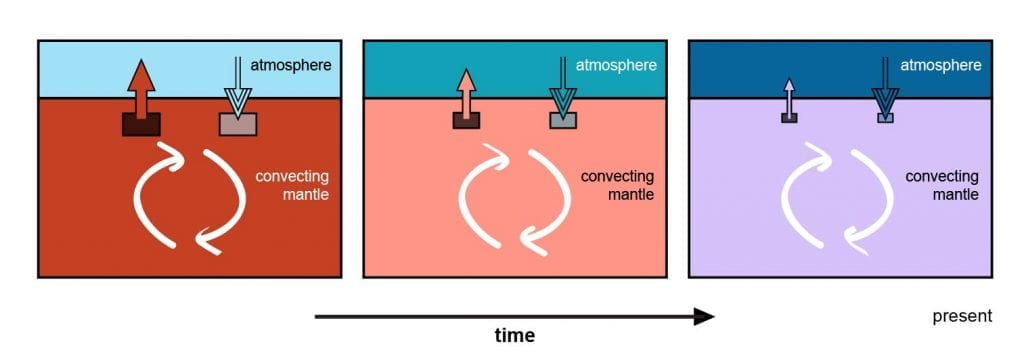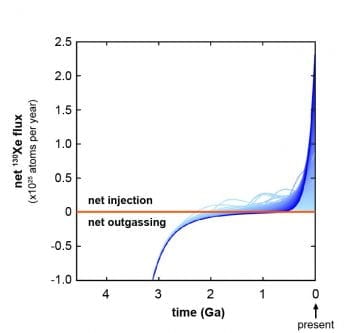Our paper published in Nature presents a model of xenon (Xe) cycling between the deep Earth and surface reservoirs. Volatiles (such as water, carbon dioxide, nitrogen and the noble gases) are outgassed from the Earth’s mantle due to volcanic activity. Surface volatiles are also injected into the mantle at subduction zones in the present day, but they may not have been injected into the mantle in the deep past. The two competing volatile transport fluxes (into and out of the mantle) give rise to variations in how volatiles are distributed between the deep Earth and surface reservoirs over very long timescales. We show for the first time that the mantle was net outgassing during the Archean, and that injection of volatiles started some time after 2.5 billion years ago.
The distribution of terrestrial volatiles controls the habitability of Earth’s surface. The abundances of water, carbon and nitrogen on Earth’s surface are important to life. The abundance of water in the deep Earth is also very important. Adding or removing water from the Earth’s interior changes the viscosity of the mantle, which affects the internal churning of the mantle, known as convection, and the operation of plate tectonics [e.g., 1]. Plate tectonics constantly reworks the Earth’s surface, generates topographic variations and plays an important role in temperature feedbacks that sustain clement conditions at the surface over long timescales.

The noble gases are useful tracers of volatile transport as they tend to follow major volatiles (water, carbon dioxide) during outgassing or injection into the mantle. In particular, Xe traces the transport of water into the mantle, as all hydrous minerals in subducting materials have been found to also carry Xe [2,3].
Our new study presents a detailed model of Xe loss from the mantle due to outgassing, Xe gain due to injection of atmospheric volatiles, and Xe ingrowth due to spontaneous fission of uranium in the mantle. There are nine isotopes of Xe, and each is distinctly sensitive to the three processes mentioned above. Furthermore, recent studies have shown that the atmospheric Xe isotopic composition evolved over time [4,5]. We used this atmospheric evolution as a temporal fingerprint of injected atmospheric Xe, and searched for model parameters that could reproduce the modern mantle Xe composition through outgassing, injection and fission ingrowth.
One can think of our numerical approach — known as a model space search — as repeatedly guessing different outgassing, injection and fission ingrowth histories and then asking the observed mantle xenon isotopic composition: Could this be what you’re saying? The answer is ‘yes’ when our predicted mantle Xe isotopic composition matches the observations within some tolerance. At the end of the effort, we ask: What do successful histories have in common?

Our study is the first to place constraints on the timing of surface volatile input into the mantle. We find that injection of surface Xe was minimal during the Archean Eon (4.0-2.5 billion years ago), and that the mantle experienced net loss of Xe throughout that time period. Substantial atmospheric Xe injection began some time after 2.5 billion years ago, and the balance tilted toward net injection of surface Xe into the mantle thereafter.
Since all hydrous minerals carry Xe, minimal surface Xe injection necessarily means that minimal surface water was injected into the mantle during the Archean. This most likely means that the mantle was drying out throughout the Archean, which would have changed the vigor of mantle convection and affected the thermal evolution of the Earth’s interior over time.
There is evidence for plate subduction prior to 2.5 billion years ago [6,7]. If plate tectonics were initiated before 2.5 billion years ago, then early subducted material was either hydrated to a lesser extent at the surface than today, or volatiles were more efficiently expelled from Archean subducting plates at shallow depths and returned to the surface.
Overall, we find that mantle xenon isotopes have a very interesting story to tell — and with new and improved measurements, we hope to learn even more about Earth’s volatiles and habitability.
- Link to the paper:
Xenon isotopic constraints on the history of volatile recycling into the mantle (web version)
Xenon isotopic constraints on the history of volatile recycling into the mantle (PDF Version) - Link to open access online version: SharedIt (view-only) version
- WashU press release: There and back again: Mantle xenon has a story to tell
- The model was developed by Rita Parai (WUSTL) and Sujoy Mukhopadhyay (UC Davis)
Refs. [1] Crowley et al. (2011), EPSL; [2] Jackson et al. (2015), Nature Geosci.; [3] Kendrick et al. (2013), EPSL; [4] Pujol et al. (2011), EPSL; [5] Avice et al. (2017), Nature Comm.; [6] Shirey and Richardson (2011), Science; [7] Hopkins et al. (2008), Nature.